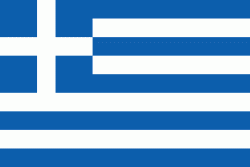Palairos (Pálairos)
Palairos (Πάλαιρος) is an ancient city and a modern town in Aetolia-Acarnania, Greece. The modern village is also known locally by the name of Zaverda (Ζαβέρδα), in official use till 1928. Since the 2011 local government reform Palairos is part of the municipality Aktio-Vonitsa, of which it is a municipal unit. The municipal unit has an area of 205.843 km2. The municipal unit was formed as the independent municipality Kekropia in 1994 from the former communities Palairos and Pogonia, and was expanded with the former communities Vatos, Plagia and Peratia as a part of the 1997 Kapodistrias reform. The name of the municipal unit was changed to Palairos in 2004.
Palairos (Παλαιρός, Palaerus) was a city of ancient Greece, situated in the southern part of the region of Epirus. The city, ruinous for centuries, is thought to have existed during the Mycenean period, since parts of the city walls appear to date back to 2000 B.C. The construction of the walls interchanges between the square-shaped and the polygonal system and the parts belong to different periods. It lies high in the mountains overlooking the Ionian sea and Lake Vourkaria. The city is thought to have had a population of over 10,000 people.
During antiquity it was part of Acarnania, according to the Theodorokoi, situated on the west coast, on the Ionian Sea, which is placed by Strabo between Leucas and Alyzia. In the first year of the Peloponnesian War (431 BCE) Palairos was in alliance with the Athenians; and when the latter people took the neighbouring town of Sollium, which was a Corinthian colony, they gave both it and its territory to the inhabitants of Palaerus. At nearby Actium, Mark Antony and Cleopatra were defeated in a sea battle by Octavius. According to tradition, the salt lake was the saviour of Cleopatra, who hid her ships there.
The citadel on the eastern part of the yard is separated by a partition and is considered to be the most ancient part of the wall, probably from the Mycenean period. The ruins are close to the present-day town of Palairos.
Palairos (Παλαιρός, Palaerus) was a city of ancient Greece, situated in the southern part of the region of Epirus. The city, ruinous for centuries, is thought to have existed during the Mycenean period, since parts of the city walls appear to date back to 2000 B.C. The construction of the walls interchanges between the square-shaped and the polygonal system and the parts belong to different periods. It lies high in the mountains overlooking the Ionian sea and Lake Vourkaria. The city is thought to have had a population of over 10,000 people.
During antiquity it was part of Acarnania, according to the Theodorokoi, situated on the west coast, on the Ionian Sea, which is placed by Strabo between Leucas and Alyzia. In the first year of the Peloponnesian War (431 BCE) Palairos was in alliance with the Athenians; and when the latter people took the neighbouring town of Sollium, which was a Corinthian colony, they gave both it and its territory to the inhabitants of Palaerus. At nearby Actium, Mark Antony and Cleopatra were defeated in a sea battle by Octavius. According to tradition, the salt lake was the saviour of Cleopatra, who hid her ships there.
The citadel on the eastern part of the yard is separated by a partition and is considered to be the most ancient part of the wall, probably from the Mycenean period. The ruins are close to the present-day town of Palairos.
Map - Palairos (Pálairos)
Map
Country - Greece
 |
 |
| Flag of Greece | |
Greece is considered the cradle of Western civilization, being the birthplace of democracy, Western philosophy, Western literature, historiography, political science, major scientific and mathematical principles, theatre and the Olympic Games. From the eighth century BC, the Greeks were organised into various independent city-states, known as poleis (singular polis), which spanned the Mediterranean and the Black Sea. Philip II of Macedon united most of present-day Greece in the fourth century BC, with his son Alexander the Great rapidly conquering much of the ancient world, from the eastern Mediterranean to the North Western parts of India. The subsequent Hellenistic period saw the height of Greek culture and influence in antiquity. Greece was annexed by Rome in the second century BC, becoming an integral part of the Roman Empire and its continuation, the Byzantine Empire, which was culturally and linguistically predominantly Greek.
Currency / Language
| ISO | Currency | Symbol | Significant figures |
|---|---|---|---|
| EUR | Euro | € | 2 |
| ISO | Language |
|---|---|
| EN | English language |
| FR | French language |
| EL | Greek language |















